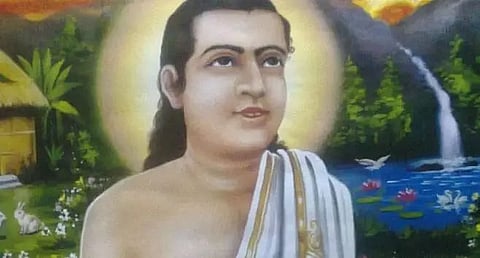
- Home
- Live Blog
- Breaking News
- Top Headlines
- Cities
- NE News
- Sentinel Media
- Sports
- Education
- Jobs

By Dr. Tridib Kr. Goswami
Performance of the stories of the tas of Sankaradeva is known as Ankiya-bhao. This Ankiya-bhao has a great impact on the life of the people of Assam. In a sense, it is a life force of the people of Assam which is significant directly for its theme, language etc. and indirectly for its characters, their dresses and bhao-audience. On the otherhand, Pala is a living performing art-form of Assam which is also found prevalent in Orissa and West-Bengal. Both the art-forms have some similarities. So a sincere attempt has been taken to focus the art-forms.
The tradition of drama in Assam is ancient. The tradition includes Putala –c, Ojapal;I, Khuliya-bhauriya, Dhuliya-bhauriya, Kushan-gan, Bhari-gan etc. The different dramatic performance enjoyed by Sankaradeva out side Assam, traditiol dramatic performances of Assam and the selected portions of ancient Sanskrit plays helped bin creating Ankiya-t in 16th century. This Ankiya- t was created for spreading the New Vaisva Dharma in Assam and the very performance of the Ankiya- t is known as Ankiya- bhao. Those Ankiya-tas are Potni-Prasad,Parijat-Haran, Kaliya-Daman,Rukmini-Haran, Keli-Gopal ,Rama-Vijoy .The different subject matters treated in the tas of Sankaradeva are taken from the Bhagavada –Pura, Harivamsa, and the Ramaya.
Ankiya-bhao possesses all the essential characteristics of Folk-drama. i.e. Dance, Dialogue, Song and Gesture. It is not a Folk-drama, but it is a developed form of Folk-drama to classical drama.All the characters of Ankiya-bhao enter with dance movement and they deliver their dialogue in Brajawali language. In the midst of the main story Borgeet is sung by Sutradhara and Gayan-Bayan repeat it. Sanskrit slokas pronounced by Sutradhara, attract the attention of the audience. '
The Pala-art-form has two other popular mes—Pala- gan and Pala-bhao..The term Pala suggests the meaning of a party or a group of dramatic performance. In many respect , this term may convey the sense of a group consists of singers and dancers. According to some active bearers of this tradition the Pala bears many similarities with the Yatra performance.It would not be irrelevant if we say that the yatra tradition was earlier than the saint poet Sankardeva, because he composed a few yatras which are still played in different sattras of Assam. As such, pala-art- form may be a product of the yatra tradition.
The tradition of pala has emerged in Assam during the period of decadence of the bhao tradition, as such we may say that the tradition of Pala is a local phenomenon. On the otherhand ,some kind of influence of the pala-gan tradition of both Bengal and Orissa may not be ruled out. Since according to a few active bearers of this art form origilly the term pala-gan was very common in Assam. The people of Assam used this term for a long time, but due to impact of the Ankiya- bhao, the second part of the term pala-gan i.e., gan was replaced by the term bhao. Nevertheless, the aged active bearers of this tradition donot forget to use the term pala-gan.
Both the above stated art-forms— Ankiya-bhao and Pala-bhao have some similarities. Those similarities are—
1. Ankiya-bhao starts with a prayer which is known as Vatima,Pala also starts with a prayer to Ganesha, known as Vanda.
2. Sutradhara of Ankiya-bhao is similar to the Viveka of Pala-art-form.Both the characters act the role of the director and keep avilabk-le themselves in the stage from the beginning to the end.
3. It is observed that the themes of both the art-forms are taken from the Bhagavata, Haribamsha, Vishnu-Pura and the Ramaya.
4. Song, Dance, Gesture,and Dialogue—these are common characteristics of both the art-forms.
5. The dresses of the characters of both the art-forms are same.
6. Khola and Tala are played in performing the both art-forms.
7. Bahua character is seen in the both art-forms who creates laughter amidst tensed scenes.
8. Both the art-forms are performed in the open stage which is also known as Khola-Mancha.
9. Generally both the art –forms are performed at night.
10. Sattriya –tradition includes both the art-forms.
11. Audience can enjoy both the performance sitting surrounding the open stage.
Thus if we observe the performance of the art-forms, we can come to a conclusion that the similarities of the art-forms are distinct and a comparative study between the art-forms is apt and suggestive.
(Writer is Asst. Professor, Dept. of English, Batadraba S.S.S College, gaon, Assam)